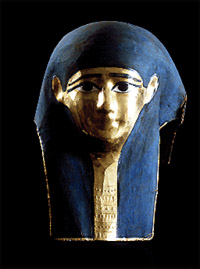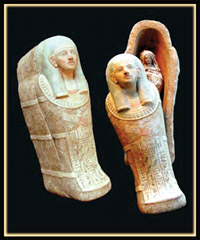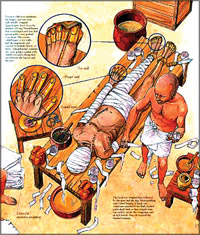|
Looking back Ancient Egypt
How mummies were made
Who hasn't heard of Egypt and its famous
pyramids, which are considered to be one of the wonders of the world? It
is one of the great civilizations that developed along the River Nile,
in North Africa over 5,000 years ago, as Upper and Lower Egypt.
ago, as Upper and Lower Egypt.
It was King Menes who united the two kingdoms in 3100 BC and made it
into the powerful empire it turned out to be. The Egyptian Empire lasted
until 30 BC, when it finally fell to the Romans. The remains of tombs,
written records and wall paintings have revealed to us today, what this
great civilization was like in the ancient days.
Egypt was a rich empire ruled by kings who were called pharaohs. They
were worshipped and treated like gods by the people. The royal family
always lived in luxury, waited on by hundreds of servants.
History records that the ancient Egyptians worshipped many gods and
strongly believed in life after death. As they believed in afterlife,
the Egyptians embalmed (preserved) the bodies of their dead. Rich
Egyptians were buried with everything they would need in the afterlife
such as food, clothes, jewellery and even models of servants.
Lucky amulets were also often placed among the bandages in which the
body was wrapped, to ward off evil spirits.
|

A mummified corpse
|
Some of the magical amulets that were placed were the ankh which
symbolises life, djed (strength and stability), tet (for protection of
the limbs) and scarab (rebirth). As these tombs contained lots of
treasure, they were often broken into and plundered by robbers.
Most of the great pharaohs' tombs were robbed long ago. However, in
1922, archaeologists made one of the world's greatest discoveries. They
found the tomb of the young Tutankhamun, who was only 18 years of age
when he died. His tomb was untouched and contained priceless treasures,
including his mummy and the fabulous golden face mask.
Today, we'll check out some interesting facts about mummies and how
they were made ...
Who was mummified?
A mummy is a dead body that has been preserved. The people who made
them were called embalmers. Making
|

Death masks
|
a mummy was not an easy task. It was also very expensive and
so, only the royal family, top officials and priests who were very
powerful helping the people with sacred work, were mummified. Some
animals too such as cats, dogs, crocodiles and baboons that represented
gods and goddesses were also mummified sometimes.
Cats for example, represented the goddess Bastet and were held in
high esteem. But, the poor people who could not afford to be mummified
were buried in simple coffins made out of reed, or just in holes in the
sand.
How was a body preserved?
You must be aware that even today, dead bodies are being embalmed in
funeral parlours. When embalming a body, the soft body parts - the
organs inside have to be invariably removed. Even in ancient times, this
was done. The Egyptian embalmers too cut opened the bodies and removed
these organs. But, instead of throwing them away like in the present
day, they dried and placed them in vessels called canopic jars.
It had taken 70 days to complete the embalming of a body and several
embalmers had been involved in the process, which was carried out in the
embalming shop called the per nefer. The chief embalmer, a priest, was
known as the hery seshta.
The first step in this process was removing the soft parts of the
body - that means all the internal organs. In
|

Death masks
|
order to do this, an incision had to be made on the left side of the
abdomen.
However, as this act of cutting open a dead body was considered a
desecration, the embalmer who did it was cursed and stoned by the others
present. But it was done as a symbolic part of the process and not with
the intention of hurting the embalmer.
As the ancient Egyptian believed that body parts magically reunited
with the body in afterlife, as we mentioned before, certain body parts
were preserved.
The parts that were dried and placed in canopic jars were the
stomach, intestines, liver and lungs.
The stoppers of these four special jars were shaped like the heads of
the four sons of God Horus; Duamutef who had a head of a jackal was
given in charge of the stomach, Qebehsenut, the falcon-headed son was
entrusted with the intestines, Hapi, the baboon-headed son was given in
charge of the lungs and Imseti, the human-headed son was entrusted with
the liver. Well, what about the heart and the brain?There is no mention
of the heart being preserved.
The brain too was removed by pulling it out through the nostrils or
nasal cavities using a hooked knife. But, as the embalmers did not think
the brain was important, they just threw it away without preserving it
in jars.
In fact, they thought it was there to produce snut only! As they
didn't consider the brain important, they treated it in a rough manner,
even when removing it. They used a sharp instrument and first separated
the bone from the brain.
Then using a long hook, they virtually liquidified the brain by
stirring it up inside the cavity. Then, the body was
|

Sarcophagi
|
turned upside down by the embalmer so that the brain could ooze
out from the nasal cavities. The body was then washed with wine (the
alcohol in it served as antiseptic to kill bacteria).
The empty spaces in the body were filled with rags and sawdust to
retain the original shape of the body, and stitched up. The body was
then covered in a kind of salt called natron, which dried it out, for 40
days.
After the body dried out, following the removal of bodyparts it was
rubbed with various kinds of sacred oil to soften the skin which was by
now shruken, leathery and wrinkled. The body was also rubbed with
spices. Then, it was wrapped in bandages as much as five kilometres
long! The assistants who bandaged the body were known as wetyu.
Even though initially no identification was given on the bandaged
body, the practice of writing the name at the ends of the bandage was
introduced at some period of time.
That is how archaeologists and scientists are able to identify some
of the mummies (even without death masks), discovered today.
Death masks and coffins
|

A corpse is being bandaged |
Once the mummy was complete, a death mask was placed over the mummy's
face. A death mask was the portrait of the dead person. It was placed
over the face, so that the soul, also called the ka would be able to
recognise its body. Most often, these death masks were made of painted
wood. However, most pharaohs had death masks turned out of beaten gold.
The mummy was then placed in a coffin which was in turn placed in one
or two other coffins known as nests. Each of these coffins (which would
be at least three) were painted with hieroglyphs (word pictures),
pictures of gods, spells to keep away evil spirits and pictures of the
person's life. These were painted by specialised coffin painters.
Some of the early coffins were in the shape of boxes, somewhat
similar to those used today. Later, they took the shape of the human
body and were known as mummie form coffins. Sometimes the mummies were
placed in what was called sarcophagi which were large coffins made of
stone or gold. Along with these coffins or the sarcophagi .
Six small statues known as shabtis too were placed in the tombs which
were also full of treasure.
Final prayers
The priest said final prayers over the body, but he always wore a
mask to look like Anubis, the jackal god, who
|

Placing magical amulets
|
was the god of the dead. At the tomb, the priest conducted what
is known as the 'Opening of the mouth' ceremony. The priest did this,
holding on to the mummy's body because the ceremony was held with the
intention of giving the dead person the power to eat, move and breathe
during afterlife.
Many interesting discoveries of mummies and ancient tombs are being
made by archaeologists, during excavations in Egypt all the time. Try to
learn as much as you can from these interesting discoveries about
mummies and the great Egyptian civilization which has given so much to
the modern world. |
